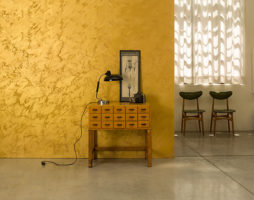Repairs in an apartment or house can be instantly ruined by a leak in the roof, a flood in the housing on the top floor. There is an effective way to protect housing from the damaging effects of moisture - covering the ceilings with a moisture-resistant and elastic PVC film, polyester or polyester fabric. Having learned how to drain water from a stretch ceiling, it will be possible to protect the decoration and interior filling of housing from destruction.
- How to drain water from a stretch ceiling: first steps
- Draining water from the ceiling through a hole for lighting equipment: a step-by-step master class
- How to drain water from a stretch ceiling over the edge of the structure
- Effective methods for drying a stretch ceiling after draining water
- The impact of water on a stretch ceiling made of PVC film and fabric
- Video
Unlike drywall and plastic coatings, vinyl sheeting has unsurpassed moisture resistance, the ability to stretch and return to its original shape after complete drying. Having given preference to this option of facing the upper part of the room, you can not worry about the state of the integral repair. This is a kind of guaranteed resistance to the flood, the elements and other reasons for the flow of water through the ceiling slab. So that the probable flooding is not taken by surprise, you need to know how to drain the water from the stretch ceiling. Having familiarized yourself with the theoretical recommendations of specialists, in practice it will be possible to easily save the house from devastation during flooding.
back to index ↑How to drain water from a stretch ceiling: first steps
In a flood, it is important not to panic, but to quickly take measures to prevent the cause of the formation of water on the ceiling:
- in apartment conditions, turn off the water supply to housing located on the upper floors;
- in private housing construction, it is necessary to identify the place of the roof leak and substitute a container under it;
- turn off the electricity in order to level the occurrence of a short circuit, the impact of an electric current when dismantling lighting fixtures or touching a wet coating.
Having created safe conditions for pumping water from a stretch ceiling, it is necessary to remove electrical appliances, household appliances, textiles, things that are vulnerable to moisture from the room. To cope with this difficult task is not easy without a single drop of water leaking onto the floor or surrounding furnishings. Therefore, furniture and flooring must be equipped with a plastic film that prevents swelling and deformation of interior details.
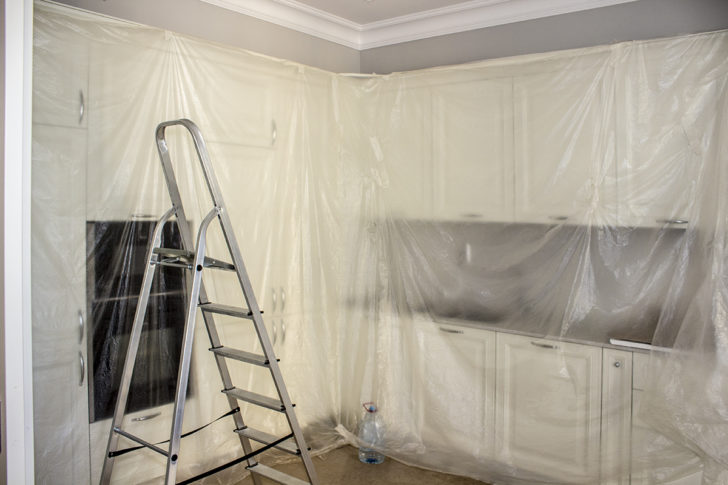
Cover furniture with plastic wrap
A large volume of water in the stretch ceiling requires the preparation of capacious tanks: buckets, ladles, basins. For the convenience of pumping out and removing the withdrawn liquid from the ceiling space, it is necessary to organize a team of 2-3 people. It is extremely difficult to single-handedly adjust the position of the canvas in the area of \u200b\u200bdraining water, drive it to the hole from different angles, lift empty containers and lower full buckets with one hand. The well-coordinated work of a team of several people is the key to a quick correction of the results of the flood, which did not affect the appearance of the stretch coating.
It is strictly forbidden to pierce the stretch ceiling with sharp objects in the area of formation of water bubbles. Under the force of pressure, a small hole will instantly become large. A torn canvas can be glued together with a patch, but it will be very noticeable against the general background.
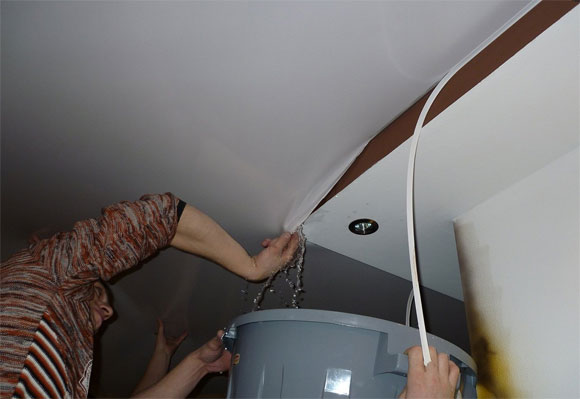
For the convenience of pumping, the participation of 2-3 people is required.
It is worth focusing on an effective way to prevent the influence of water on the neighbors' housing from the lower floor, where the ceilings are covered with PVC film or fabric. Floor waterproofing reliably keeps liquid from penetrating the edges of the room with a reliable moisture-resistant coating.
back to index ↑Draining water from the ceiling through a hole for lighting equipment: a step-by-step master class
Step-by-step instructions will help you quickly and easily pump water from a stretch ceiling:
- Place a stable table or a sturdy stepladder under the drain hole.
- After de-energizing the room, you need to disconnect the lighting equipment from the power supply. The installation location of spotlights, a chandelier or a ceiling lamp is ideal for removing accumulated liquid.

Disconnect lighting equipment from power supply.
- The profile that fixed the edges of the canvas in the lighting installation area should be unscrewed.
- It is reasonable to bend the edges of the canvas only at the moment when the container for collecting water on the stretch ceiling is ready. Otherwise, leakage to the floor is inevitable, which is highly undesirable when flooring is made of non-moisture resistant laminate or carpet.
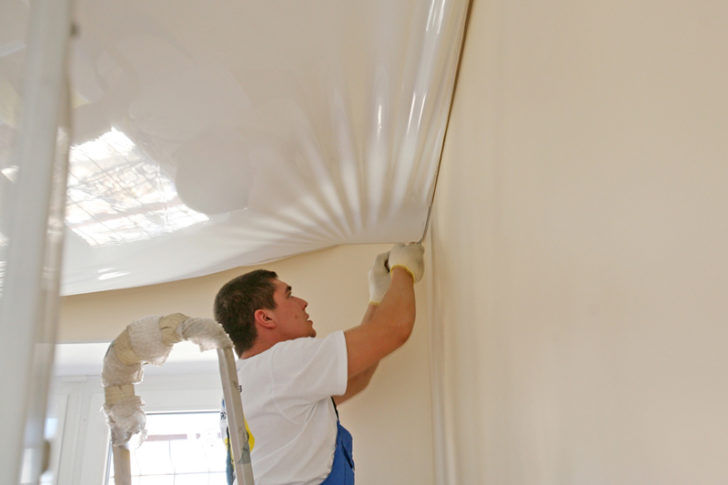
Draining water from the edge of the canvas
- If the water bubble is located near the hole for the lighting equipment, then by pressing from different sides, the liquid will gradually drain on its own. If water has collected at a remote distance, a flexible hose should be used. You need to run it under the canvas very carefully and not in a hurry. Otherwise, the basis of the structure can be torn. It is non-recoverable.
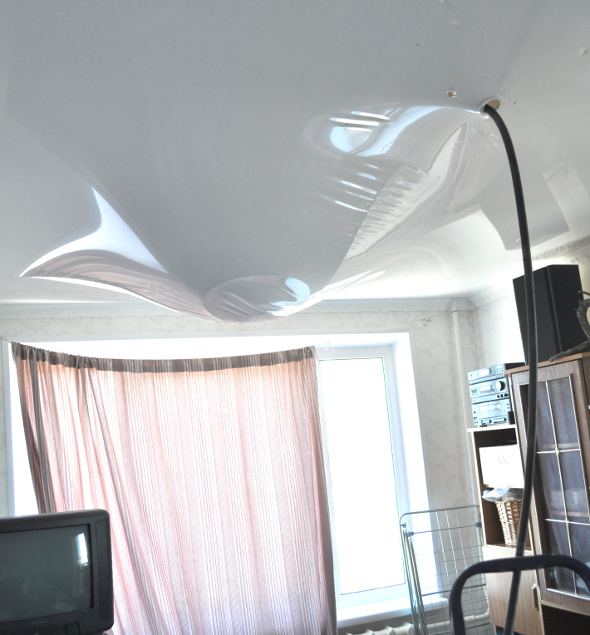
Use a flexible hose to drain
- After draining the water from the stretch ceiling, the canvas and the slab should dry completely within a week. Then a film with a glossy effect or a woven base should be screwed to the profile and the lighting equipment should be returned to its place.
The primary task when filling the ceiling space between the slab and the tension coating with liquid is to detect places where water accumulates. With small volumes, a barely noticeable sagging of the canvas is created. If its weight is large, then an overall formation is formed that visually resembles a bubble. The most effective method of removing it is to connect it with a rubber hose and gradually pump it out.
back to index ↑How to drain water from a stretch ceiling over the edge of the structure
In the absence of lighting equipment, a perfectly smooth ceiling covering can be freed from water only by dismantling one corner edge of the panel. Also, if the place of its collection is far from the hole for lighting equipment, then it makes no sense to overtake it. It just spreads out in different directions. In this case, it is reasonable to partially pull the tension structure out of the fixing profile and carefully remove it by moving it partially to the drain area.
Different technology for installing a tension structure involves methods of removing the edge of the panel from the profile that differ in execution:
- The wedge design provides for the installation of baguettes around the perimeter, fastening of the tension base, fixing with an angled insert and glazing beads. To release the edge of the panel, you need to remove the insert, pull the wedge a short distance and bend the film or fabric.
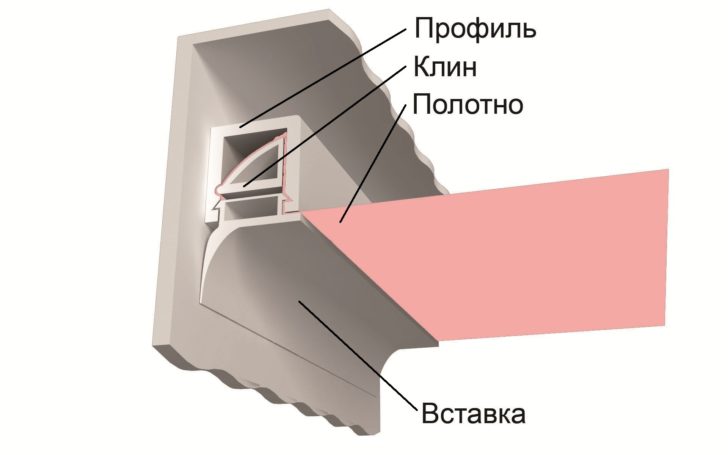
Wedge design stretch ceiling
- The fastening system with a latch involves the release of the web by pressing on it at the very edge with the profile. To set it, you will need a specialized spatula.
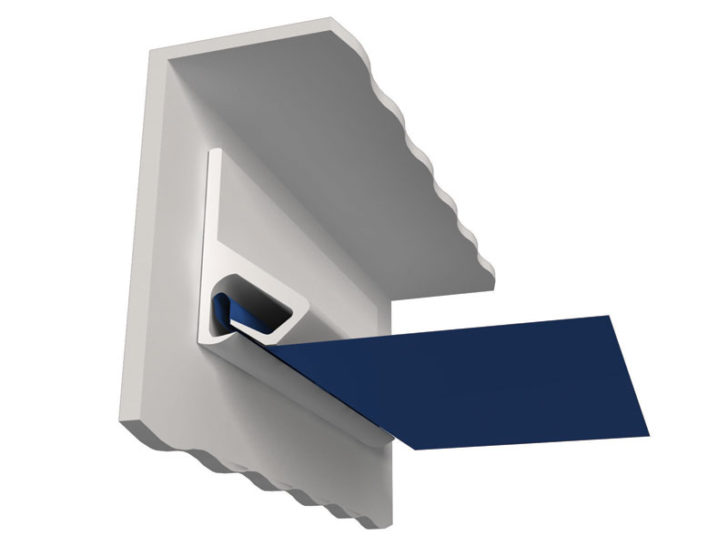
Clip fastening system
- Harpoon mounting design with a masked baguette requires the use of a tool with a flat base and non-sharp rounded edges like a plastic card or spatula to clear the ice from the freezer. With it, you need to press the edge in an upward direction.
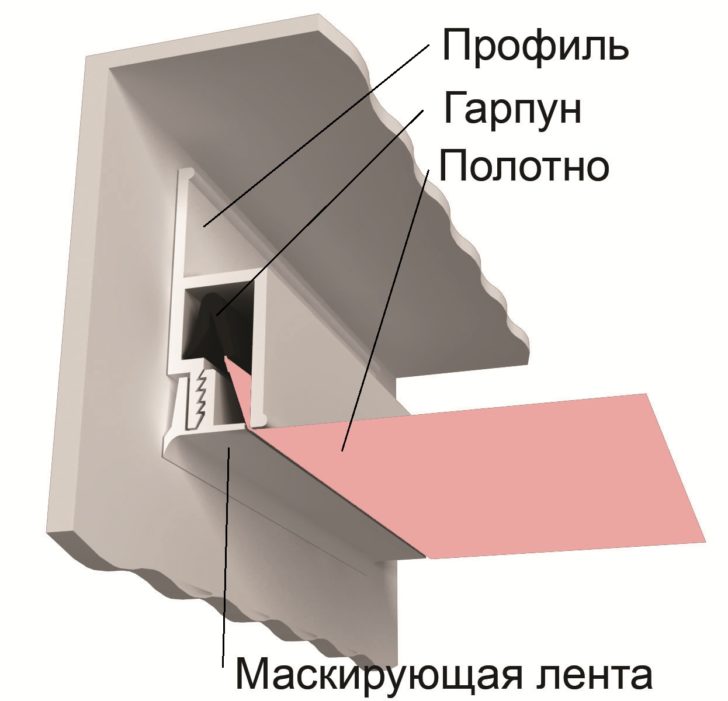
Harpoon mounting structure
- The cord fastening of the fabric web is extremely easy to dismantle to pump water from the ceiling space. A strong cord is inserted tightly into the profile with a narrow gap, calculated on the diameter of the fastening rope. To bend the panel, it is enough to stretch its edge and pull it down strongly. To return the cord to its original position, just press it against the gap on the profile and press hard.
Having disconnected the edge of the cloth from the baguette, you need to substitute a container and create an inclined trajectory that is optimal for draining for water to drain. After completion of all work and drying, the canvas should be returned to its place: filled into the profile using a specialized flexible spatula with a rounded shape or specialized tools.
back to index ↑Effective methods for drying a stretch ceiling after draining water
The appearance of the tensile structure depends on the volume of liquid and the time spent in the ceiling space. With a quick pumping out of a small amount of water, it will practically not change its original shape. If the load was more than 100 liters per 1 m² area, then the place of its accumulation will visually resemble a deflated balloon of overall size or a wrinkled coating.
To restore the former appearance of the stretch panel, pleasing to the eye with impeccable smoothness and dazzling brilliance, it is worth using heat treatment methods. To do this, it is advisable to use specialized equipment: a heat gun or a building hair dryer. Due to the heating of the vinyl film under the influence of high temperature, the polymer coating self-levels during cooling, and the places of the stretched base disappear without a trace. The use of hair drying equipment is not suitable for these purposes due to insufficient power.
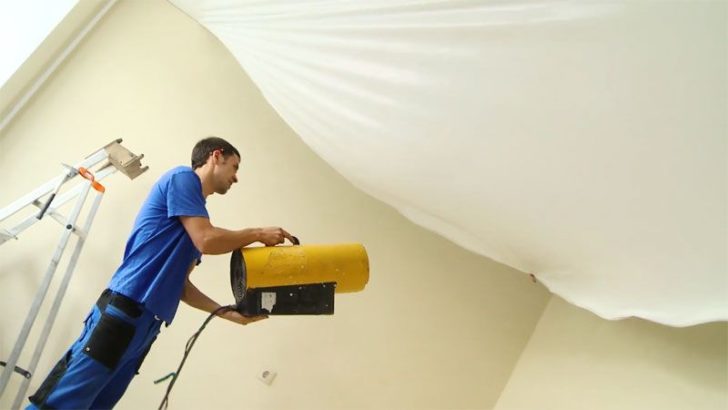
The heat gun will even out the wrinkled coating
Excessive heat may cause the vinyl to melt and deform. Therefore, the building hair dryer must be kept at a distance of 20-30 cm from the stretched part of the stretch ceiling, constantly maneuvering it from one side to the other.
Surprisingly, after high-quality drying of the PVC fabric, traces of the formation of places for collecting and draining water become absolutely invisible. Stretch ceilings take on their former impeccable-looking form, and only memories of the flood remain in the memory.
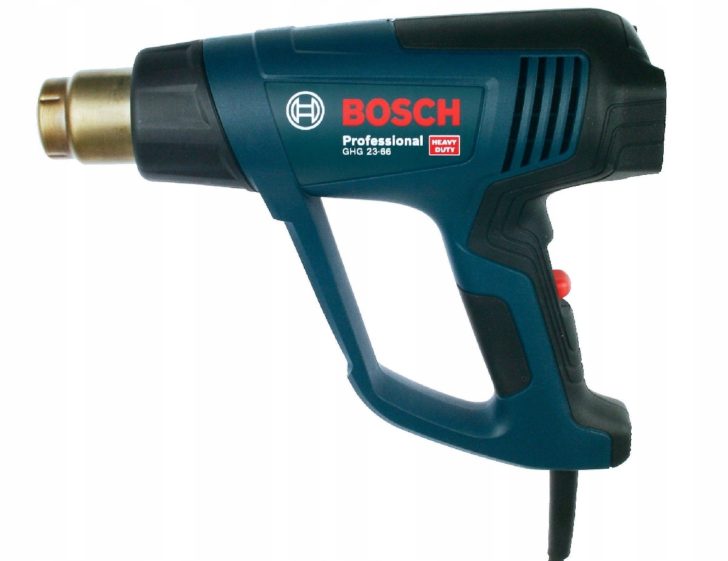
Traces of the formation of water collection points can be removed with a building hair dryer
The impact of water on a stretch ceiling made of PVC film and fabric
It is possible to successfully prevent the consequences of a flood only if high-quality stretch ceilings are installed and the installation is flawlessly performed at a high professional level. The condition of the coating after exposure to water is determined by the operational properties of tension materials:
- Polyvinyl chloride film is characterized by excellent elasticity, water resistance, and resistance to the formation of condensate in rooms with a high level of humidity. Under the influence of water, it does not change color and shape, is not saturated with liquid and does not get wet. With the harpoon method of attachment, it can be completely removed and re-tensioned if it is impossible to get rid of the water in a more rational way. When liquid gets on the wrong side of the PVC fabric, it accumulates in one place, stretches the coating downward and in breadth, but does not spread.
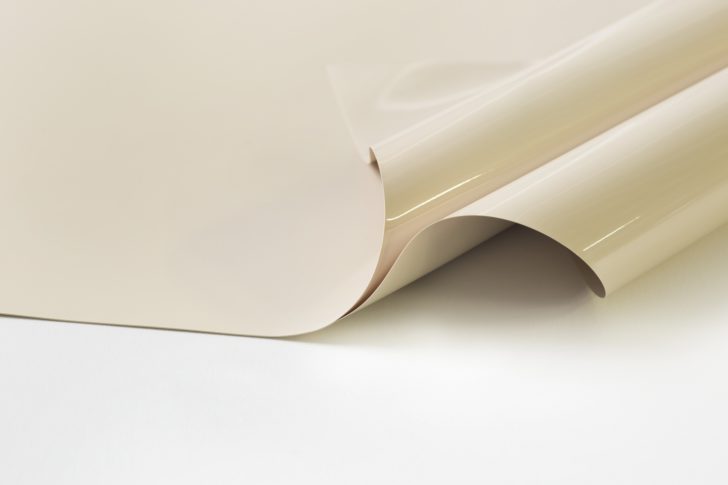
Polyvinyl chloride stretch ceiling is not saturated with liquid and does not get wet
- A fabric stretch ceiling with water will not spill liquid on the floor only if it is sufficiently impregnated with polyurethane or evenly varnished. A seamless, durable canvas, fixed with a cord fastening, can withstand a large volume of water - more than 100 liters. Due to insufficient elasticity, under excessive load, it can come off the baguette. The porous structure of the fabric is prone to fluid seepage.
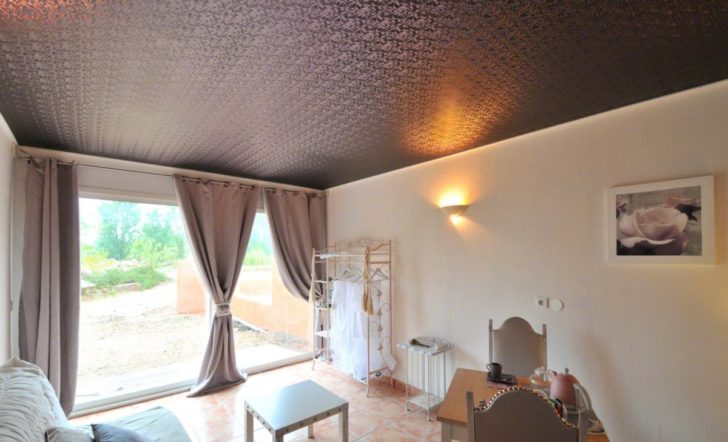
Fabric fabric is prone to seepage of liquid
With a lack of free time, it is not possible to drain water from the ceiling on your own immediately after discovering the consequences of the flood. The main thing is to determine the source, and then stop the flow of fluid. Vinyl flooring is able to retain water for a long time. It is advisable to remove it from the ceiling space in the next few days. In addition, the junction between the two soldered parts of the vinyl coating may crack.
With a long stay of water in the ceiling space, there is a high probability of mold on the stove, which will require dismantling the tension coating and disinfecting it with antiseptics. For reinsurance, it is advisable to use them to cover sections of the draft ceiling and panels that have been exposed to moisture. It is much more problematic to remove the black traces of mold that appear on the tension basis, spoiling its appearance and worsening the microclimate in the house. To prevent this, the minimum amount of time should be water in the stretch ceiling. The ceiling must be given time to dry. In the summer, a board, vinyl film or woven backing can become completely dry on its own very quickly. In seasons with high humidity and low air temperatures, it is advisable to use a building hair dryer or a heat gun, which can return the structure to its previous appearance in a matter of minutes, preventing the formation of harmful mold.
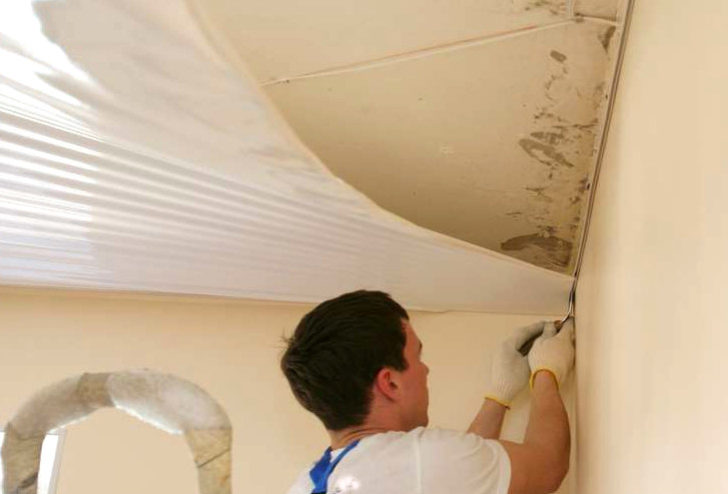
Mold may form if left in water for a long time.
During the flow of water through the ceiling plate, the impact of drops on the tightly stretched membrane of the panel is clearly audible. The sooner an emergency situation is recognized, the easier it will be to organize the pumping of water and prevent a strong stretching of the tension base. Having figured out how to drain water from a stretch ceiling, you will be able to personally eliminate the consequences of a flood that arose for various reasons. In case of difficulties, it is reasonable to contact the service that performed the installation of the tension structure.
back to index ↑Video

